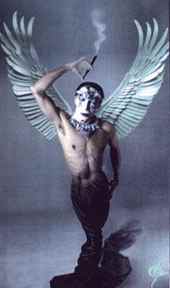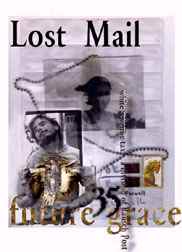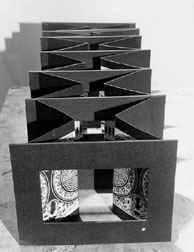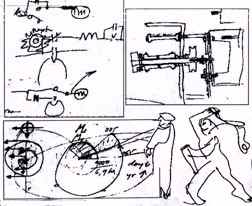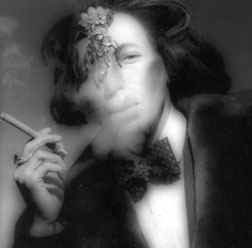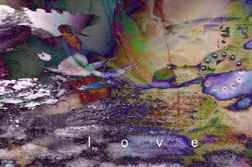|
|
TEXT-BOOK of INSANITY:
John Rininger, Norym,
Jno Cook, Keith DeWeese,
Oberc, Michael Thompson,
Michael Hernandez de Luna,
John Center, Anonymous
April 1 - May 1,
2000
Las Manos Gallery
5220 North Clark Street
Chicago, Illinois 60640
Telephone: 728-8910
Original review at
http://www.artscope.net/VAREVIEWS/BookofInsanity.html
One thing one can say about "Text-Book of Insanity" is that none of its authors are crazy; or, in a society where the inmates often run the asylum, they may well be crazy -- like a fox. "Text-Book of Insanity" is the current exhibition at Las Manos Gallery and it will be open to the inmates of this world until May 1, 2000. "Text-Book of Insanity" presents the work of eight Chicago artists: John Rininger, Keith DeWeese, Oberc, Norym, John Cook, Michael Hernandez de Luna, John Center, Michael Thompson; and 'Anonymous.' (However, Kilroy, Duchamp and The U.S. Engraving Company skulk about the shadows, at least, in spirit.)
This exhibition takes its title from the book by Krafft-Ebing. Chicago artist John Rininger is prominent in "Text-Book of Insanity," and it is his copy of Chaddock's translation (F.A.Davis: 1904), a presentation copy inscribed by the translator, with inserted correspondence -- and modifications to the book by that artist -- which cornerstones the showing. (Rininger's Great Grandfather, Will, was a doctor in "Nervous Disorders," and a friend of Krafft-Ebing and Chaddock.) Textbooks on insanity seem to run in the family. A large portion of Rininger's contribution are the 41 stamp sets on the North wall: finely executed artist's stamps, which mimic, play against, invert, or even subvert the familiar postage formats and conventions. Each piece is a meticulous print, and a visual delight, a conceptual free association without control or rationale. Many of these bear the artist's own 'Rausch Post' imprint, and, in conspiracy with "The Norym Project," encorporate images and analogicals from Norym, a co-exhibitor here. Among the many, Rininger's Glamour and Death Excise Tax and his Lost Mail - future grace - white revenue tax stamps are representative, although formats also range through diamonds, ellipses and even 'a rather large recursive doll' patterned from triangular elements. (This can be viewed at http://www.prdf.com/art/john.html with more stamps images at http://www.prdf.com/art/art.html ). Rininger links with "The Norym Project" include a somewhat 'Deco- Fantastique ' "Grand Duchy Norym," "with a denomination of Logical Annihilation," namely the math symbols for "0 not-equals 0." Interestingly, that thought here dictates an metalogical subtext: '0' can denote the 'absence of anything,' null; but equally stands in for 'absence of something,' placeholders (as in '1 00 .') Like many of the earlier Surrealists, artists in this exhibition often abandon reason's control only to hit against hard logic. Crazy. Like a fox.
|
|
John Rininger is also represented in "Text-Book of Insanity" by one larger and a second, smaller scroll, both of which are mounted between plexiglass panels. Many of Rininger's panel images constitute digital abstractions with text overprints. They create an impression of subliminal wallpapers: something of a para-pharmaceutical, optic mindflash with telegraphic seizures from a verbal monitor about the alert, but sporadic mind. One should note that the http:spaces.org/manos.html website offers work not in the Las Manos showing, often items which better the gallery display. "Text-Book 0f Insanity" at Las Manos Gallery includes several 'moving pictures,' and among the tapes is Rininger's Scroll (1983), a 200-yard tape of free-association images -- a 'stream of consciousness' composed of what the artist terms "automatic effluvia at its finest": Dr. Dee, Stockhausen, Greae, lorgnettes, Druidiana, sulfur, rhomboids, pogroms and much more.
|
|
Scrolls, broadsides and the familiar 'codex' books -- book leaves bound in covers -- are different means toward a function: the conveyance of 'texts,' written or in image. Evolutionist Stephen J. Gould notes that in biology form and function may diverge, cross, substitute: In crustaceans, limbs become mouthparts; in vertebrates, gills evolve into jaws; and in mammals, select jawbones became the textbook hammer, anvil and stirrup of the inner ear, amplifiers to hearing. In "Text-Book of Insanity," artist Oberc pushes the codex book to its outer, recognizable limits; Oberc diverges, crosses, and substitutes. The artist books of Oberc pay lip-service to the book archetype, but build on elaborated, three-dimensional fold-outs -- 'pop-ups,' employing multiple hinge cuts and foldings in a Piranessi-esque page layout. Oberc's scratchboard renderings for the textural surfaces have evolved into sculptural constructs which tenuously gravitate toward the raison d'livres .
|
|
Artists such as Masereel and Lynd Ward have executed purely visual books -- without words, 'stories in images.' Oberc abandons even visual narration. His black and white geometricized patternings evoke three-dimensional computer contour plots of wave, force, harmonics -- the ordered asymmetries of Chaos Theory; and these work in tandem with ingenious page cuts and folds, some cased in at the book-spine, others in concertina format. In Oberc's artist books, art is both container and contained. Each book is a gratifying device of aesthetic strength and structure. Oberc also is exhibiting more such books at the Burchardt Studio, Halsted Street.
Jno Cook's 'retrievals' from a putative C.I.A. dumpster mount and enshrine pages of crypto-electronic diagrammatics and wild scribblings worthy of Graham Greene's Our Man in Havana . In this showing, there are two standing panels of 14 pieces; and two more of 21 items; however zealous visitors will find 500 visuals with introduction at http://jnocook.net/diagrams
Andre Breton, in his 1924 Manifest du Surrealisme -- Poisson Soluble , in part defined Surrealism as:
Pure psychic automatism, by which it is intended to express, whether verbally or in writing, or in any other way, the real process of thought. Thought's dictation, free from any control by the reason [my italics], independent of any esthetic or moral preoccupation.
In A Concise History of Modern Painting by Herbert Read: Thames and Hudson: 1974)
|
|
(And all the while we thought someone was in control!) Jno Cook reconstructs the Buck Rogers fantasies of clandestine functionaries; an over-wrought Walter Mitty-ism of the fatigued mindset which so often plagued the 'Cold Worriers' who confused Pentagon and Pentagram. Interspersed among the seemly benign electronic schemata and formulae, are flashes of immediate, brute violence, which suggest how easily distance and technology make death a quick button's push away. In simple, at times even naive line, Cook captures that spirit of technology which has nurtured anonymous death on a grand scale. (It is said that even Hitler was squeamish about visiting sites with casualties or of massive war damage.) Within Cook's sketches, as in life, cause and effect -- sequence-- drift and take on lives of their own. The only defense may be, as for Graham Greene, to submit altered blueprints of vacuum cleaners as the fruits of espionage. Implications lurk beyond Jno Cook's display: if the exhibits are indeed to be from a C.I.A. dumpster, how could they have escaped a paper shredder? And if their dumpster pulled rank upon shredder, either the dumpster's site, or the artifacts' retrieval must give us pause to ponder. Cook's art may save us yet; or merely provide direction and delight.
George Louis Leclerc de Buffon, in his 1753 address to the French Academy, declared Le style c'est l'homme meme. And for Norym, as one viewer put it, the stylist is 'his own artform.' In "Text-Book of Insanity," the photography is by Michael Voltattorni; the subject/object -- a collaborator who makes himself a cabaret of fantasies, a collage of camouflage, and who sculpts in flesh and artifact -- Norym. Perhaps the best work is indeed on the exhibition website, but all the Norym pieces, even where self-indulgent, provoke the eye; and many fascinate. "Wings" plays on 1920s Deco: and as much evokes the photography of Andre Kertesz or Rudolf Koppitz as it links with Nick Knight's 80s and 90s photos or Terry Gilliam's film, Brazil . Seasons , three photos in series, each with increased exposure, i.e. each successively darker, does strike one as obvious, even cliche , but "Puffsilk" is pleasing, and Showtime , a triptych -- Norym as a somewhat Las Vegas style Bird-of-Paradise -- is Camp. Showtime bears the text: "It's not always so easy. But the show goes on and your dreams perform brightly." It is Norym; and often Norym harkens to the spirit of Man Ray, as in the latter's Barbette (Borderline: 1988). Jean Cocteau, in his 1926 essay on Barbette deflected the bourgeois barb of 'bad taste' by asserting: "All the souls that are confused, in trouble or in despair, exhausted by the forces threatening us in this life and beyond death do find some peace in such an apparition." It could well serve as a summation of "The Norym Project."
|
|
Michael Hernandez de Luna, an artist of 'neither rain, nor sleet, nor dark of night': A carrier toward disaffected rounds: Presently a creator of alternate documentations and perhaps reminiscences. Michael Hernandez de Luna is represented in "Text-Book of Insanity" by 12 framed ensembles, which present a printed artist's stamp sheet, often with a portion excerpted and reunited now, mounted in cancelled state on an addressed envelope. (And, like the virgin birth, one's at a loss to explain how it came to be, but it sparks much notice. (Disclaimers for Officialdom have been proffered.)
Keith DeWeese provides the major video element to "Text-Book of Insanity": The Spider Wife (1999) [A man contemplates an egg sac...]; Box (1999) [A man opens a box...]; and Lumen Sex Death Pyx (1994) [I turn on the monitor...]. "I turn on the monitor" leaves some ambiguity as to whether the verb does duty for 'activate,' or 'betray.' The 'Love' image by John Rininger was used as the Video Box cover of DeWeese's Lumen Sex Death Pyx . Frankly, it is hard to decide just what one's own response to these images are (a portent); a visitor would require more time than an average visit to absorb the medium.
John Center, took his BFA at Carbondale, Illinois, but afterwards taught himself engraving -- wood, copper and steel -- and engraves bogus banknotes as well as facsimile postage stamps. Center assimilates authentic banknote designs for his remodelings. The artist's statement clarifies the Las Manos showing by noting three parts: "The Block Book and Postmortem collaboration"; Black and White copies of some prints in the two artist's books, framed in elaborate handmade frames; and some blocks and plates themselves. If art (traditionally) counterfeits life, and if it is the ever so slightly unlife-like which delights by betraying the artifice, that may explain the curious pleasure of John Center's work. In one of the hung frames Japanese banknotes eclipse American bills, while at the lower right an example of his individually facsimiled Chinese stamps descends down to the lower frame. This, and Center's Chinese postal stamps, draw close attention -- seemingly exotic, they are just so very well conceived. And among the wood-engraved and letterpress banknotes, Dominion of Canada , innocent and false, seems both a tour de force , and a whim; high technique, and fun.
|
|
In the mid 1920s, Antonin Artaud, directing the 'Bureau of Surrealist Enquiries,' expected the public's collaboration; he expected that a floating popular unease with the status quo would welcome art such as the Surreal. Artaud declared: "We need disturbed followers more than we need active followers." (In Surrealist Art by Sarane Alexandrian: Thames and Hudson: 1985). Surrealism was social and cerebral, perceptive and politicized ... Dada abandoned even that. There is an analogic to "Text-Book of Insanity"; it associates freely, unmasks stowaway motives and rationalizations; ranges from wry satire, innocent insights, theatrical release, toward high skill in the service of humble effluvia. One comes away with the uneasy revelation that "Text-Book of Insanity" is just what no doctors ordered: at odds, not so much with art, as with the marketeer, and the snake-oil brains of art 'appreciationship': ("Take two Toulouse too loose and fault me in the mourning....")
Some, artist and critics alike, proclaim that the contemporary art world is ever more like an insane asylum; which just about suits contemporary society. But, if the inmates are also keepers, the artists in "Textbook of Insanity" are deceptively crazy... like a fox. "Textbook of Insanity" will run at Las Manos Gallery in Chicago's Andersonville neighborhood, 5220 North Clark Street, Chicago, until May 1, 2000. It's worth a visit. And additional visuals for "Text-Book of Insanity" are accessible at http://spaces.org/manos.html and, for Rininger, at http://www.prdf.com/art/art.html and http://www.prdf.com/art/john.html John Cook's work is at http://jnocook.net/diagrams
--G. Jurek Polanski
Jurek Polanski has previously written and art edited for Strong Coffee in Chicago. He's also well known and respected among the Chicago museums and galleries. Jurek is currently a Visual Arts Correspondent for ArtScope.net.
